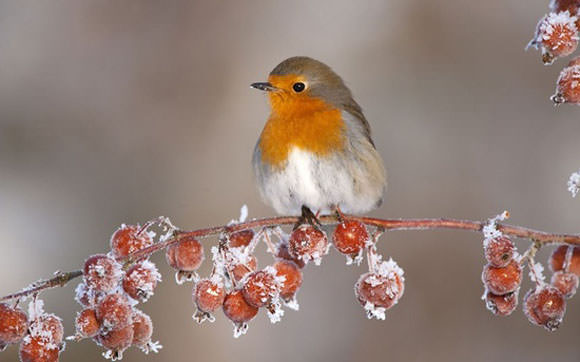






Recent research indicate that the bird population and varieties are in decline, and in some urban areas some species are in rapid decline and on the verge of becoming extinct. Much of this has to do with the urbanisation of our towns and cities, but also the development of rural areas. There is perhaps a sense of powerlessness to prevent the relentless development and consequential loss of valuable hedgerows and green spaces in the countryside, but within our urban environments, especially in our gardens there is much we can do. During the winter months, when food sources become scarce, there is a number of things we can do to help our feathered friends survive this very challenging and harsh time of the year.
Planning Plants – yes, planning make sense, choose varieties that can provide dense cover for the smaller birds and protection for the larger species. Clearly plants which are also a source of food are ideal.
Select shrubs which provide berries, fruit and/or hips. Popular choices include pyracantha, wild roses, cotoneaster, mountain ash, holly, berberis and crab apple are all excellent choices.
Leave an untidy pile of timber and/or leaves in one hidden area, an ideal habitat for hibernating hedgehogs, which incidentally are natural predators of slugs.
Providing Food – if your garden isn’t quite ready or sufficiently developed to provide natural sustenance and cover, you can provide much needed daily food supplements to help the local bird population. There is an enormous range of bird feeder types and sizes as well as foodstuffs to choose from and most good garden centres, DIY stores, even the local Hardware grocer, will all be well stocked with product at this time of year. So whether your preference is for feeder tables, boxes, nets or balls, be very careful in selecting the position. Avoid any areas where predators such as cats could be a hazard, best to choose open locations where smaller birds especially can access area safely and yet have good visibility of lurking predators and larger birds etc.
Regular Feeding – sometimes, one can be very enthusiastic and provide copious amounts of food, this is not a good idea. Better to provide small amounts on a regular basis, e.g. provide a daily feed, in this way, no food will be wasted or left to linger which might potentially attract rodents. During very cold spells, be sure to provide a source of water which has become frozen.
A few simple but regular measures can make a huge difference to your local winter garden wildlife.
For more tips, advice and practical insights into garden design and landscaping, visit: http://www.owenchubblandscapers.com
Copyright © www.100flowers.win Botanic Garden All Rights Reserved